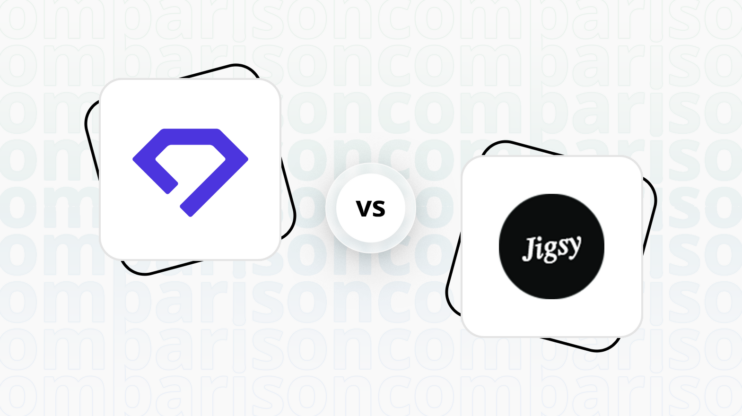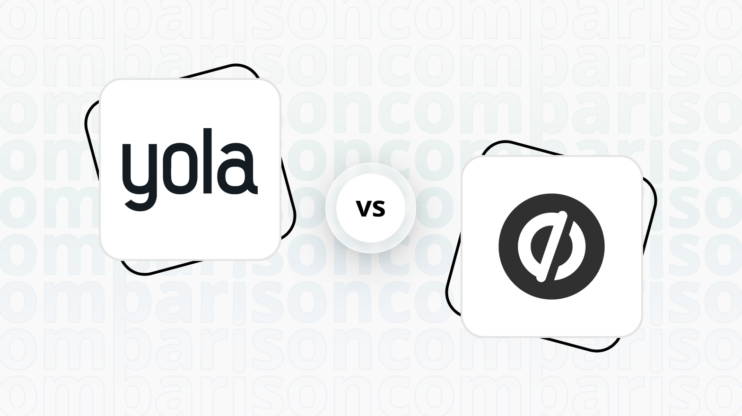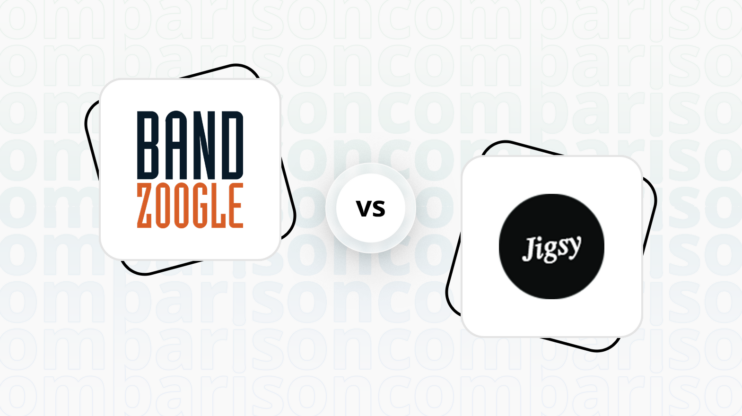GoDaddy vs Adobe Portfolio: Final verdict
GoDaddy and Adobe Portfolio cater to different user needs, each excelling in their respective domains.
-
GoDaddy (Overall Grade: 7.5/10)
is a versatile platform offering a comprehensive suite of services for website creation and management. It is ideal for users seeking an all-in-one solution with robust ecommerce capabilities, extensive design functionalities, and reliable hosting. When comparing GoDaddy vs Adobe Portfolio, GoDaddy stands out for its wide range of templates, advanced marketing tools, and superior customer support, making it a strong choice for businesses and individuals looking for a flexible and powerful website builder. -
Adobe Portfolio (Overall Grade: 5.5/10)
is tailored specifically for creative professionals who want to showcase their work in a visually appealing manner. It excels in ease of use and seamless integration with Adobe Creative Cloud, making it perfect for photographers, graphic designers, and artists. In the GoDaddy vs Adobe Portfolio comparison, Adobe Portfolio is the go-to platform for creatives who prioritize design and simplicity over ecommerce and extensive customization options.

|

|
|
|---|---|---|
|
Design functionalities & templates |
8.0 |
7.4 |
|
Ease of use |
8.2 |
8.7 |
|
Ecommerce |
7.2 |
0.0 |
|
Website Editors |
6.7 |
7.4 |
|
Product testing options |
8.1 |
7.6 |
|
Price |
7.9 |
7.7 |
|
Hosting quality |
7.8 |
7.0 |
|
Website speed optimization |
7.6 |
6.2 |
|
Plugins/extensions and integrations |
7.3 |
6.7 |
|
Marketing features |
7.3 |
3.7 |
|
Customer support |
8.5 |
7.3 |
|
Website security |
6.8 |
8.1 |
|
AI capabilities |
7.5 |
0 |
|
User Management |
7.3 |
3.0 |
Which one is the best for ecommerce: GoDaddy or Adobe Portfolio?
 7.2
7.2
 0.0
0.0
Verdict
: GoDaddy is a more suitable option for ecommerce, offering a range of features to support online stores, while Adobe Portfolio lacks ecommerce capabilities entirely.
-
GoDaddy
: GoDaddy provides a user-friendly experience for setting up and managing online stores. It offers integrated payment processing, flexible shipping options, and comprehensive tools for product and order management. Additional features like abandoned cart recovery and discount codes enhance its ecommerce functionality. When comparing GoDaddy vs Adobe Portfolio, GoDaddy clearly stands out for ecommerce needs. -
Adobe Portfolio
: Adobe Portfolio is designed for creative professionals to showcase their work and does not offer any ecommerce features. It is ideal for photographers, graphic designers, and artists looking to build a professional online presence, but it is not suitable for setting up and managing an online store.
Which one is the best for informational and business websites?
 7.9
7.9
 7.4
7.4
Verdict
: GoDaddy is a more versatile choice for informational and business websites, offering a comprehensive platform with a wide range of templates and hosting options. Adobe Portfolio, while excellent for creative professionals, is more specialized and may not provide the same level of flexibility for general business needs.
-
GoDaddy
: GoDaddy excels in providing a broad array of services, including domain registration, web hosting, and a user-friendly website builder. It offers over 1500 templates catering to various industries, making it a versatile choice for business websites. With a score of 7.9, GoDaddy is well-suited for users seeking a comprehensive platform with extensive design functionalities and reliable hosting. -
Adobe Portfolio
: Adobe Portfolio is tailored for creative professionals, offering a user-friendly interface and seamless integration with Adobe Creative Cloud. It allows users to create visually appealing, responsive websites without coding. Scoring 7.4, Adobe Portfolio is ideal for photographers, graphic designers, and artists looking to showcase their work, but it may lack the versatility needed for broader business applications. When comparing GoDaddy vs Adobe Portfolio, Adobe Portfolio stands out for its ease of use and design focus for creatives.
GoDaddy vs Adobe Portfolio: Detailed comparison
Design functionalities & templates
Design FunctionalitiesRepresents how well each platform allows for creative design and customization of websites.Score Components:
- Template Variety (30%): Range and quality of design templates.
- Customization (30%): Flexibility and options for design alterations.
- User Interface (20%): Ease and intuitiveness of the design process.
- Responsiveness (10%): Adaptability to different devices and screen sizes.
- Innovation (10%): Unique design features and tools.
 8.0
8.0
 7.4
7.4
🏆
Winner: GoDaddy.
If you’re looking for a platform that offers more creative control, a wide array of design features, and a larger number of templates, GoDaddy is the preferred choice.
GoDaddy provides an extensive collection of over 1500 website templates catering to diverse industries and design preferences. These templates cover business, ecommerce, creative, personal, and non-profit sectors, offering various styles such as modern, classic, bold, minimalist, and content-focused. With customization options, mobile responsiveness, and a combination of free and premium templates, GoDaddy aims to meet the needs of users seeking versatile and visually appealing website designs.
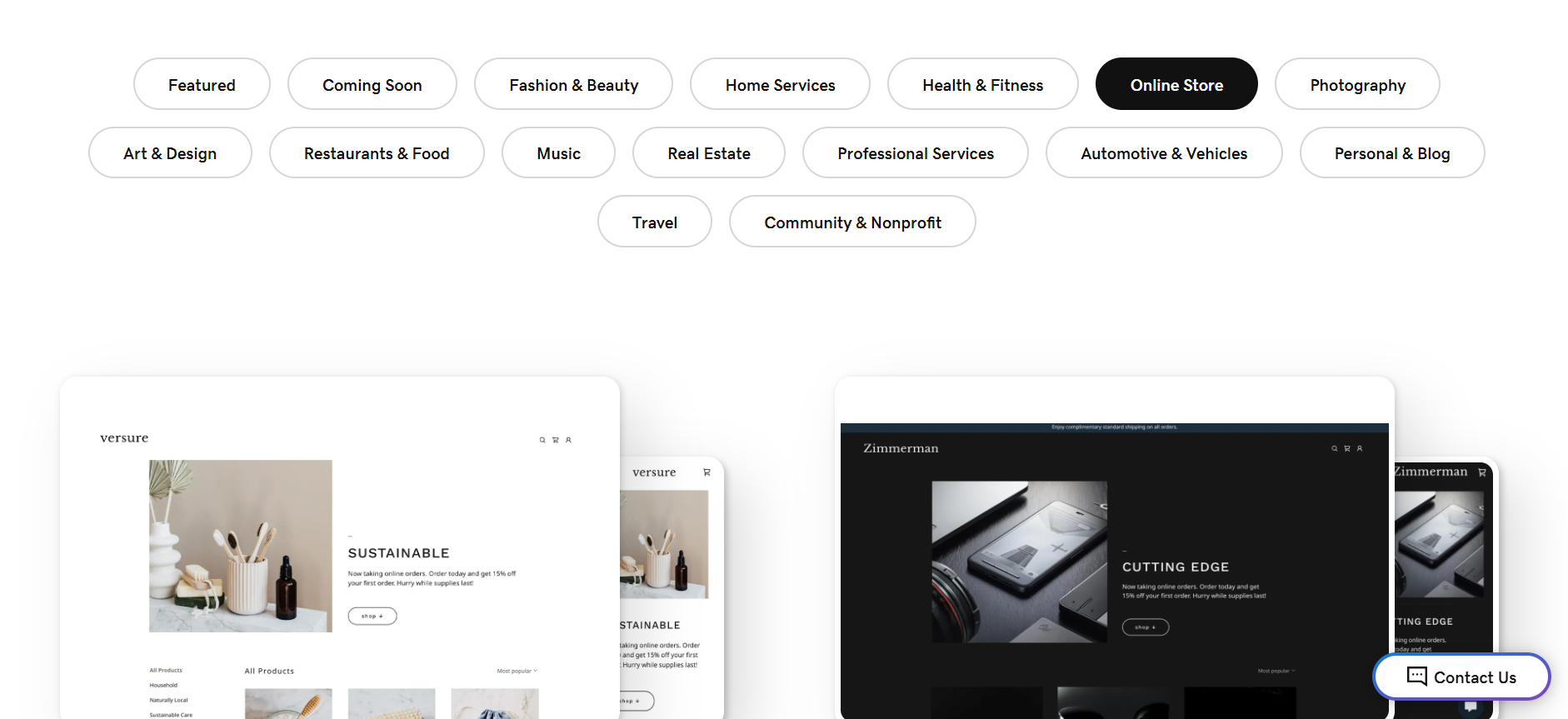

On the other hand, Adobe Portfolio offers a selection of customizable templates designed for creatives across various fields, such as photography, graphic design, and web design. These templates are responsive and tailored to showcase creative work effectively across all devices. With the intention of adding more layouts over time, Adobe Portfolio provides a flexible foundation for users to personalize and present their projects in a polished manner.
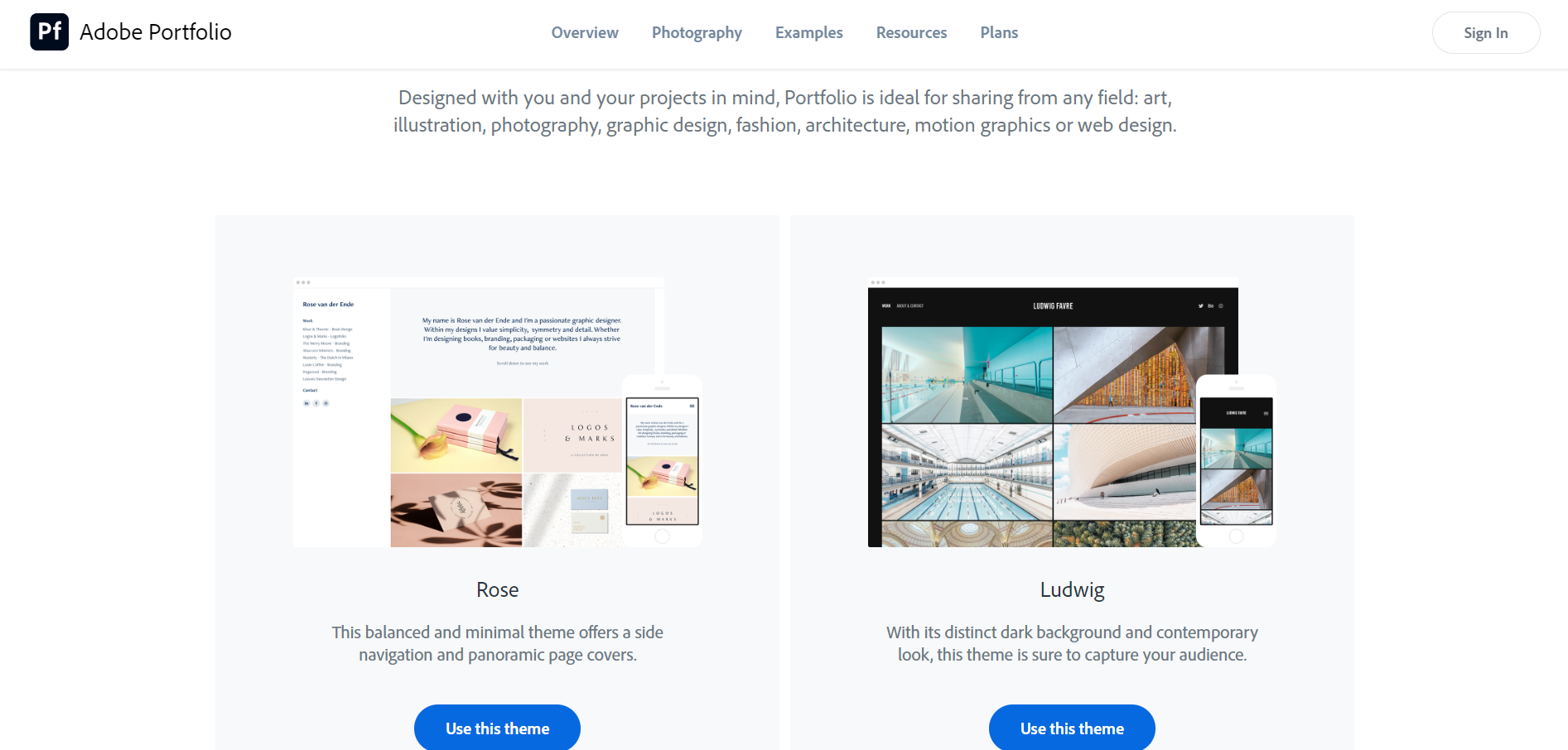
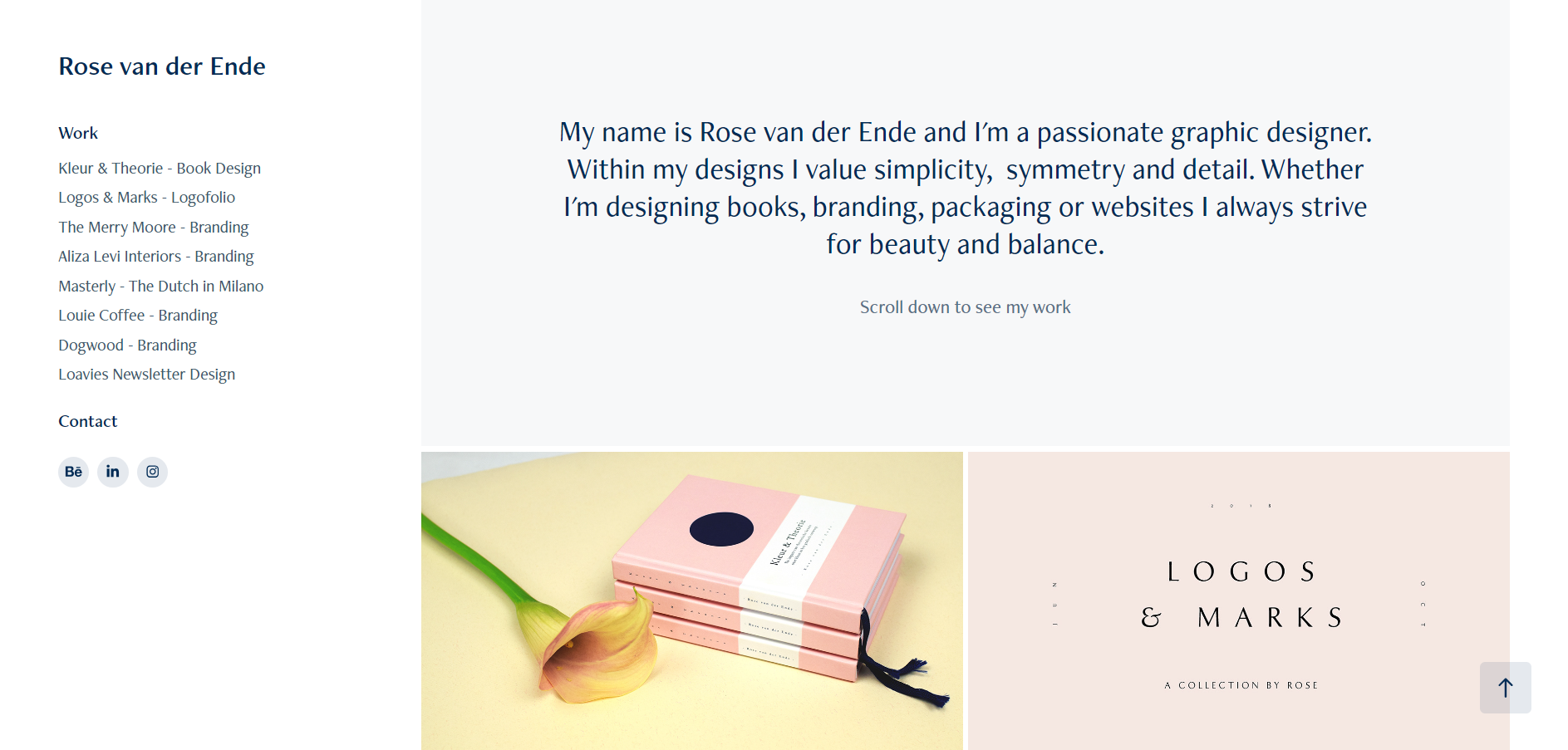
Get a head start on website creation with AI
Create a custom website tailored to your business needs 10X faster with 10Web AI Website Builder!
Ease of use
Ease of useReflects the platform’s overall user-friendliness.Score
Components:
- Learning curve (40%): Quickness and ease of getting started.
- Interface design (30%): Simplicity and intuitiveness of layout.
- User guidance (20%): Quality of tutorials and support.
- Flexibility (10%): Adaptability to various user skills.
 8.2
8.2
 8.7
8.7
🏆 Winner: Adobe Portfolio
. With a score of 8.7, Adobe Portfolio edges out GoDaddy (8.2) in terms of ease of use. Adobe Portfolio’s user-friendly interface and seamless integration with Adobe Creative Cloud make it an excellent choice for creative professionals looking to showcase their work. GoDaddy, while also user-friendly, is more suited for beginners and non-technical users looking for a comprehensive platform for website creation and management.
Learning Resources
🏆 Winner: Adobe Portfolio
. Adobe Portfolio offers extensive and varied learning resources, including detailed tutorials and interactive guides, making it easy for users to create and manage their online portfolios. GoDaddy also provides a range of learning resources, but these are more tailored to different services and may not be as detailed for additional services like ecommerce and marketing.
For ecommerce
EcommerceMeasures the platform’s effectiveness in supporting online business activities.Score Components:
- Ecommerce themes and templates (20%): Variety and design of templates.
- Product management (25%): Ease of managing and organizing products.
- Payment options (25%): Variety and convenience of payment methods.
- Ecommerce features (20%): Features for managing an ecommerce store.
- Integration (10%): Compatibility with external e-commerce tools and services.
 7.2
7.2
 0.0
0.0
GoDaddy provides a user-friendly experience for setting up and managing online stores. It offers an easy-to-use website builder, integrated payment processing, flexible shipping options, and comprehensive tools for product and order management. Businesses can also utilize marketing tools, analytics, and additional features like abandoned cart recovery and discount codes to enhance their online retail operations.

|

|
|
|---|---|---|
|
Ecommerce themes and templates |
6.5 |
0.0 |
|
Product page customization |
6.0 |
0.0 |
|
Payment processing and commissions |
7.5 |
0.0 |
|
POS capabilities |
6.0 |
0.0 |
|
Payment gateways |
7.0 |
0.0 |
|
Product numbers |
7.0 |
0.0 |
|
Additional ecommerce features |
6.5 |
0.0 |
GoDaddy ecommerce features:
- Payment processing
- Shipping options
- SEO tools
- Email marketing features
- Social media integrations
- Detailed reports
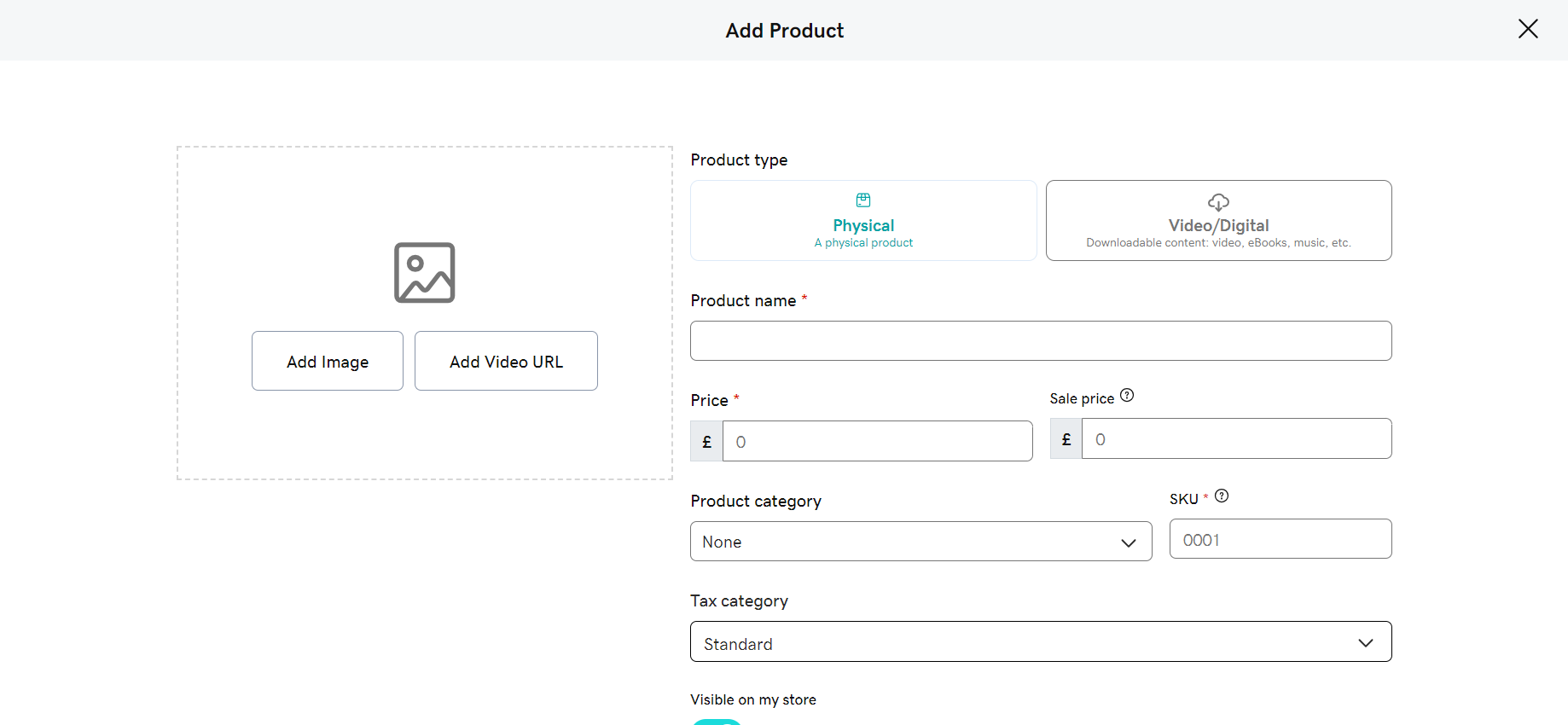
Adobe Portfolio, on the other hand, does not have ecommerce capabilities. It is a website builder specifically designed for creative professionals to showcase their work, and does not offer any features for setting up and managing an online store.
Ecommerce themes & templates
GoDaddy’s ecommerce themes, numbering around 70-80, cover diverse industries and styles, with categories including fashion, electronics, food, and more. While generally mobile-friendly with basic customization options, these themes may lack the niche variety and cutting-edge designs found on dedicated ecommerce platforms, and extensive design changes might necessitate coding knowledge within the builder’s framework. Adobe Portfolio does not have any ecommerce specific templates.
Product page customization
GoDaddy’s ecommerce platform offers users basic customization options like editing content, adding images, and adjusting layouts. For advanced customization, coding knowledge is required, enabling features such as custom CSS, third-party app integrations, and the creation of unique product page templates. Additional features include managing product variations, organizing information with tabs, and implementing discount codes and promotions directly on the page. Adobe Portfolio does not have product page customization features.
Payment processing
GoDaddy Payments provides a versatile solution for online, in-person, and phone payments with a tiered pricing structure. Generally, online transactions have the lowest fees (2.3% + 30¢), while in-person and manually entered transactions have slightly higher rates (2.3% + 0¢). While featuring a transparent pricing model, user-friendly Smart Terminal for in-person transactions, and a virtual terminal for remote payments, it may lack advanced Point of Sale (POS) features. Acting as its own payment gateway, GoDaddy Payments offers simplicity, but users requiring specific integrations with shopping carts or CRM systems may find limited support. Adobe Portfolio does not have any payment processing capabilities.
Website Editors
Website EditorsEvaluates the platforms’ website building and editing capabilities.Score Components:
- Customization tools (40%): Range and power of editing features.
- Editor usability (30%): User experience within the editor.
- Design flexibility (20%): Freedom in layout and design changes.
- Update and maintenance ease (10%): Simplicity of updating and maintaining the site.
 6.7
6.7
 7.4
7.4
🏆
Winner: Adobe Portfolio
. Adobe Portfolio, with a score of 7.4, offers a user-friendly website builder editor designed for creatives to showcase their work. With it, users can easily create and customize their own professional-looking websites without needing to code. The editor allows for the integration of high-quality images and videos, offers a variety of responsive templates tailored to different creative fields, and provides seamless Adobe Creative Cloud integration, enabling users to directly import their work.
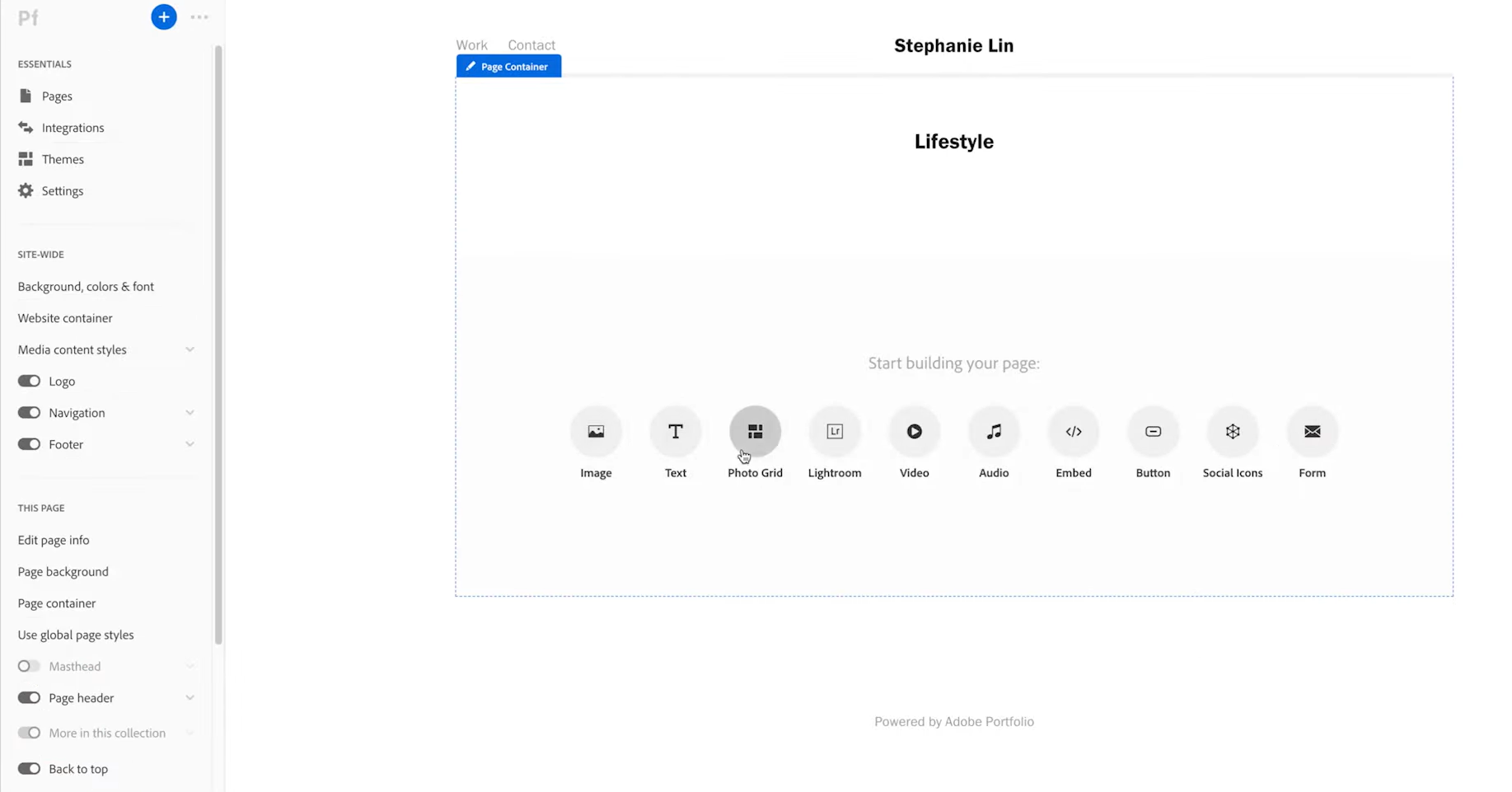
GoDaddy’s editor, scoring 6.7, is a user-friendly drag-and-drop tool enabling website creation without coding. It offers pre-designed templates, a mobile-friendly interface, basic SEO tools, and ecommerce integration, making it accessible for beginners, with affordable pricing plans and an all-in-one solution. However, it has some design limitations, basic features compared to dedicated platforms, a learning curve for extensive use, and potentially limited third-party app integrations.
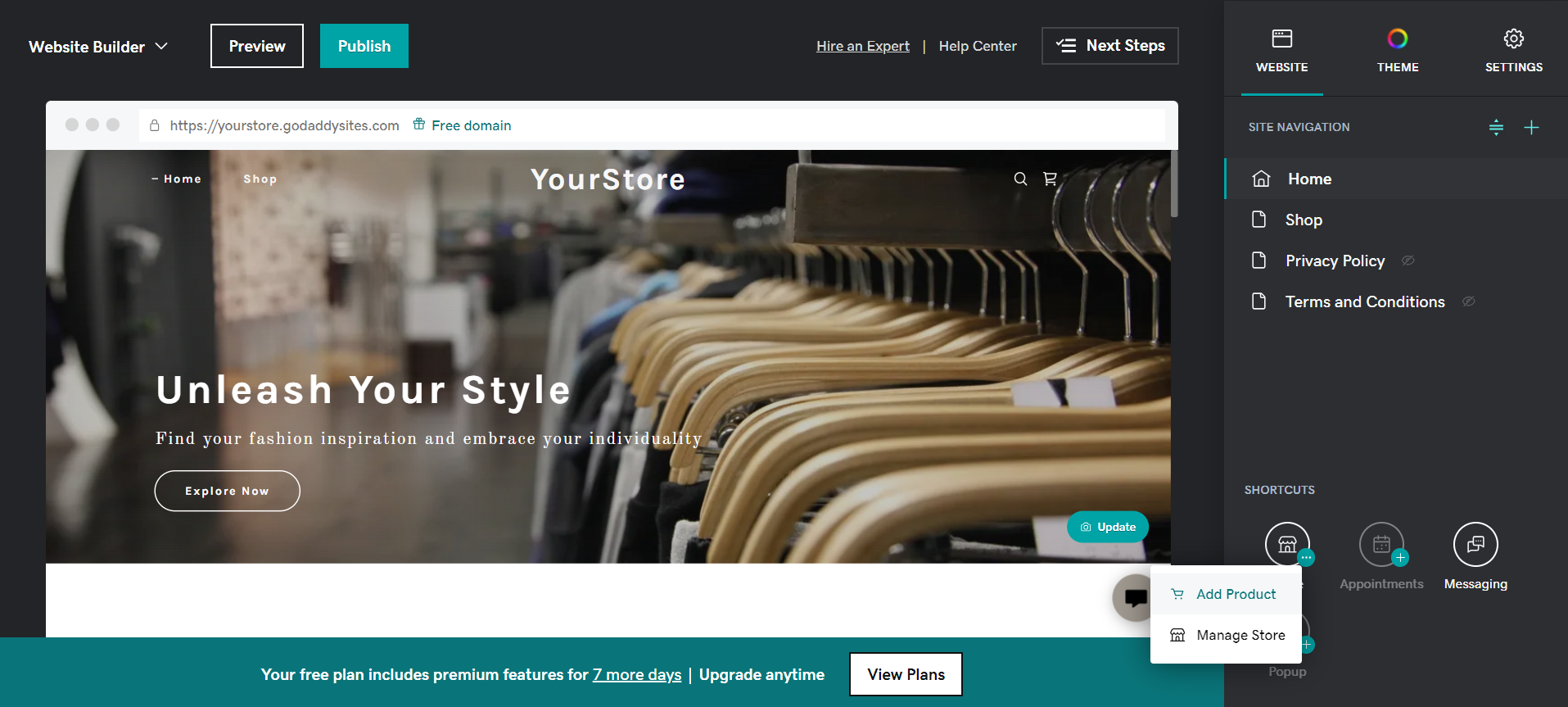
Mobile editor/app
 5.5
5.5
 0
0
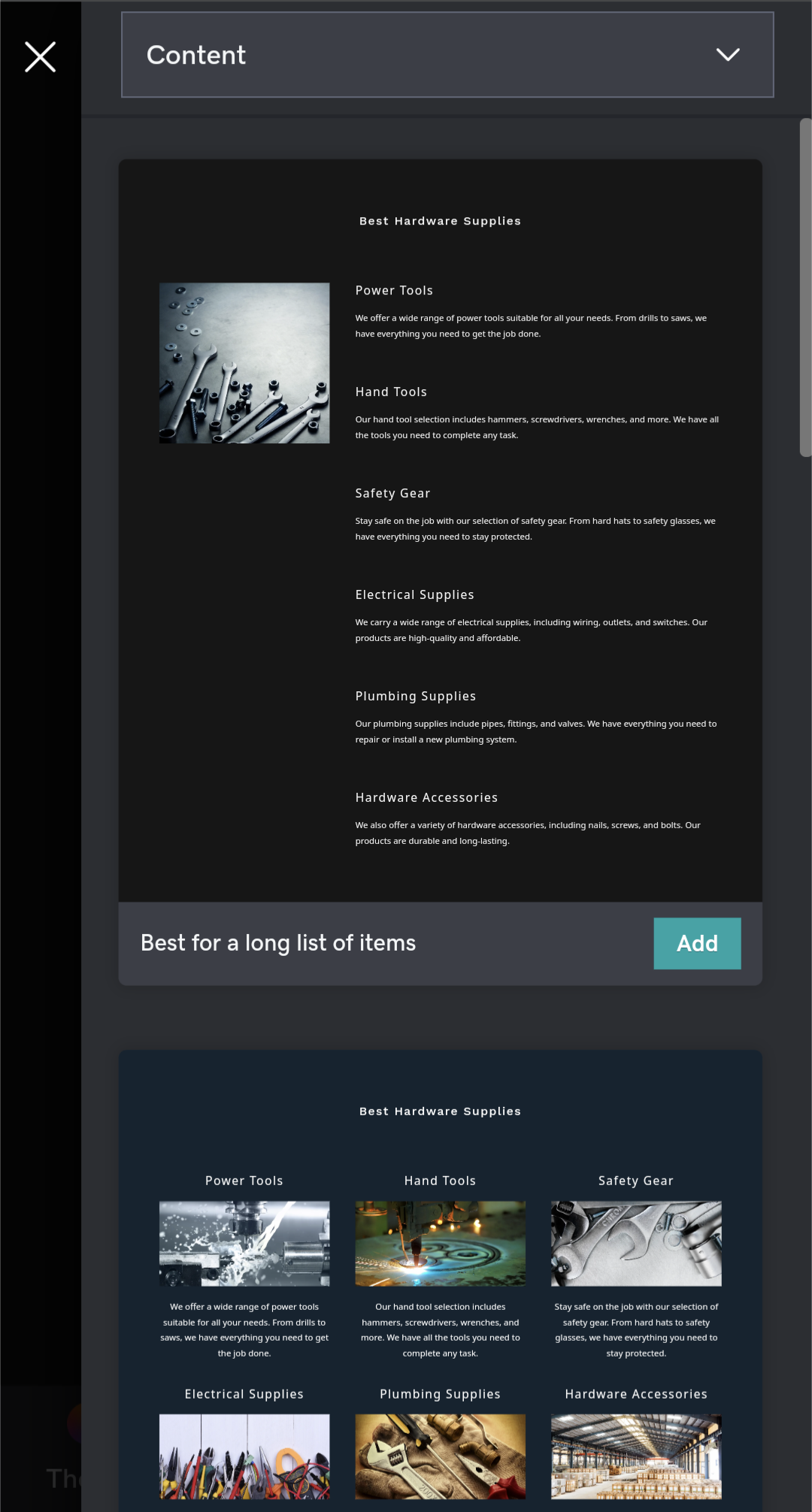
🏆
Winner: GoDaddy
. Neither GoDaddy nor Adobe Portfolio offer a dedicated mobile app for editing websites. However, GoDaddy allows users to log into their account and access the website builder through a mobile web browser. This provides some level of convenience for users who need to make quick changes on the go, even though the experience might be slightly more constrained on a smaller screen.
On the other hand, Adobe Portfolio does not have any mobile editing capabilities, which can be a significant drawback for users who prefer to work on their websites from their mobile devices.
In summary, GoDaddy receives a higher rating due to its ability to be accessed and used on a mobile web browser, while Adobe Portfolio lacks any mobile editing capabilities, making it less convenient for users who prefer to work on their websites from their mobile devices.
Product testing options
Product Testing OptionsAssesses the options for trying out platform features before commitment.Score Components:
- Trial quality (40%): Extent and usefulness of the trial or free version.
- Feature accessibility (30%): How many features are available to test.
- Trial duration (20%): Length of the trial period.
- Ease of transition (10%): Smoothness of moving from trial to paid plans.
 8.1
8.1
 7.6
7.6
Overall Result
:
GoDaddy wins
. GoDaddy scores 8.1, slightly higher than Adobe Portfolio’s 7.6. GoDaddy offers a free version and a 30-day money-back guarantee, allowing users to explore all features of any paid plan and get a full refund if not satisfied. Adobe Portfolio, on the other hand, offers a trial version and a 14-day money-back guarantee, but users cannot publish their website without subscribing to a plan.

|

|
|
|---|---|---|
|
Free Plan |
Yes |
No |
|
Trial Duration |
No (30-day money-back guarantee) |
Yes |
|
Testing Premium Features |
Full refund within 30 days if not satisfied |
Cannot publish without a plan |
Price
PriceLooks at the cost-effectiveness and value for money of each platform.Score Components:
- Plan value (40%): What each pricing tier offers.
- Transparency and clarity (30%): Clearness of pricing structures.
- Flexibility of plans (20%): Range of options to suit different budgets.
- Hidden costs (10%): Additional expenses not included in the plan.
 7.9
7.9
 7.7
7.7
GoDaddy and Adobe Portfolio have similar pricing scores, but GoDaddy offers a wider range of plans, including a free option and more advanced ecommerce features. Adobe Portfolio, on the other hand, is more focused on creative professionals and integrates with Adobe’s suite of design tools.

|

|
|
|---|---|---|
|
Free |
Free ($0/month): Build a basic website with limited templates, storage, and features. Ideal for testing the platform. |
No offering at this amount. |
|
$0-$8 |
Basic ($5.99/month): More templates, custom domain support, email marketing, SEO tools, social media integrations, analytics. Ideal for personal websites and small businesses. Value for price: 6.5 |
No offering at this amount. |
|
$8-$10 |
Premium ($9.99/month): All Basic features + blog, ecommerce with product listings and payments, advanced marketing tools, and analytics. Ideal for businesses with online sales or growing web presence. Value for price: 8.0 |
Creative Cloud – Photography ($9.99/month): Up to 5 Portfolio sites with fonts from Adobe Fonts, and with access to Photoshop and Lightroom and 20GB storage. Value for price: 7.0 |
|
$10-$18 |
Commerce ($15.99/month): All Premium features + advanced ecommerce tools like cart recovery, discounts, reviews, memberships, and unlimited products. Ideal for businesses with significant online sales and complex product offerings. Value for price: 9.0 |
No offering at this amount. |
|
$18-$20 |
Pro ($19.99/month): All Commerce features + priority support, higher bandwidth, website security, and CDN. Ideal for businesses with high traffic and critical online presence. Value for price: 9.5 |
No offering at this amount. |
|
$50+ |
No offering at this amount. |
Creative Cloud – All Apps ($59.99/month): Up to 5 Portfolio sites with the entire collection of Adobe creative apps, including Photoshop, Illustrator and InDesign, with 20 GB storage. Value for Price: 8.5 |
location. As a result in rare cases the prices displayed here can differ from the ones you see on their
websites.
Hosting quality
Hosting
qualityExamines the reliability and performance of the hosting solutions.Score Components:
- Uptime (40%): Consistency and reliability of website availability.
- Speed (30%): Loading times and performance.
- Bandwidth and storage (20%): Sufficiency of resources provided.
- Data centers (10%): Quality and distribution of hosting infrastructure.
 7.8
7.8
 7.0
7.0
Winner: GoDaddy
. GoDaddy offers a variety of hosting types, including shared, VPS, dedicated, and WordPress hosting, and guarantees a 99.9% uptime. It also has data centers in multiple countries, providing more reliable and faster services. Adobe Portfolio, on the other hand, offers cloud hosting with 20GB of storage and data centers in three countries. However, it does not provide an uptime guarantee or publish its uptime statistics, which makes GoDaddy a more reliable choice for hosting.

|

|
|
|---|---|---|
|
Do they offer hosting? |
Yes, included in all of their plans |
Yes, included with a built-in myportfolio.com domain and 20GB of cloud storage |
|
Data Centers: |
Data Centers in USA, France, Germany and UK Cloud Services Through AWS |
3 globally: US, Ireland and Japan |
|
Type of hosting: |
Shared Hosting, VPS Hosting, Dedicated, WordPress Hosting |
Cloud Hosting |
|
Uptime: |
99.9% |
Adobe Portfolio does not publish its uptime statistics |
|
Uptime Guarantee: |
Yes, 99.9% |
No |
Website Speed Optimization
Website Speed OptimizationEvaluates optimization of website loading timesScore Components:
- PageSpeed Score (30%): Google’s score indicating performance optimization.
- Loading Time (30%): The average time until a website is fully interactive.
- Mobile Optimization (15%): Optimization effectiveness for mobile devices.
- Resource Optimization (15%): Optimizing images, scripts, and other heavy resources.
- CDN Usage (10%): Use of CDN to enhance speed across geolocations.
 7.6
7.6
 6.2
6.2
🏆 Winner: GoDaddy
Both GoDaddy and Adobe Portfolio have strategies for website speed optimization, but GoDaddy’s comprehensive approach and specific improvements give it the edge.

|

|
|
|---|---|---|
|
Focus |
CDN, Automatic Maintenance, Resource Optimization |
Image optimization, SEO and Meta Tag Configurations |
|
Performance Tools |
Infrastructure upgrades, caching mechanisms, image optimization tools, automatic minification of code files |
Not disclosed |
|
Key Strategies |
CDN, Automatic Maintenance, Resource Optimization |
Image optimization, SEO and Meta Tag Configurations |
|
Load Times |
Shared Hosting: 2-4 seconds, VPS Hosting: 1-2 seconds, Dedicated Server: 0.5-1.5 seconds |
Varies depending on design choices and content volume |
|
Page Speed Scores Range |
Shared Hosting: 50-70/100, VPS Hosting: 70-85/100, Dedicated Server: 80-95/100 |
Not disclosed |
|
Core Web Vitals Improvement |
Infrastructure upgrades, improved server infrastructure and data centers, effective caching mechanisms, image optimization tools, automatic minification of code files, optimized templates and code structures for efficient rendering |
Not disclosed |
GoDaddy’s approach to enhancing site speed includes a range of strategies such as CDN, automatic maintenance, and resource optimization. It has also made significant improvements to its Core Web Vitals through infrastructure upgrades, including improved server infrastructure and data centers, resulting in faster loading times. Additionally, the implementation of effective caching mechanisms, image optimization tools, and automatic minification of code files contribute to a smoother user experience and improved Core Web Vital metrics. The website builder features optimized templates and code structures for efficient rendering, further enhancing overall performance.
On the other hand, Adobe Portfolio focuses on image optimization and SEO for speed optimization. However, it does not provide specific load times or PageSpeed scores, and does not disclose any information about its Core Web Vitals improvements. Adobe Portfolio’s emphasis on simple portfolio websites should ensure good loading times and Page Speed scores, but the lack of specific information makes it difficult to compare with GoDaddy’s comprehensive approach.
Get a head start on website creation with AI
Create a custom website tailored to your business needs 10X faster with 10Web AI Website Builder!
Plugins and integrations
Plugins and integrationsMeasures the range and effectiveness of additional plugins and integrations.Score Components:
- Variety of options (40%): Range of available add-ons.
- Integration smoothness (30%): Ease of integrating plugins into the site.
- Quality of plugins (20%): Functionality and reliability of the options.
- Custom integration capabilities (10%): Support for custom or third-party integrations.
 7.3
7.3
 6.7
6.7
🏆 Winner: GoDaddy.
With a score of 7.3, GoDaddy offers a more versatile range of plugins and integrations, especially for users of its Managed WordPress Hosting. Adobe Portfolio, scoring 6.7, provides a more focused set of integrations designed for creative professionals, but lacks the breadth of options available with GoDaddy.
However, it’s worth noting that Adobe Portfolio’s integrations are included at no extra cost for Creative Cloud subscribers, while GoDaddy’s plugins may come with additional fees.
Marketing Features
Design FunctionalitiesRepresents how well each platform allows for creative design and customization of websites.Score Components:
- Template Variety (30%): Range and quality of design templates.
- Customization (30%): Flexibility and options for design alterations.
- User Interface (20%): Ease and intuitiveness of the design process.
- Responsiveness (10%): Adaptability to different devices and screen sizes.
- Innovation (10%): Unique design features and tools.
 7.3
7.3
 3.7
3.7
🏆
Overall Winner: GoDaddy
. GoDaddy offers a comprehensive suite of marketing tools, including SEO, email marketing, blogging, social media integration, analytics and reporting, and ads and promotions. Adobe Portfolio, while offering basic SEO and social media integration, lacks in email marketing, blogging, and ads and promotions.

|

|
|
|---|---|---|
|
SEO Tools |
|
|
|
Email Marketing |
|
|
|
Blogging |
|
|
|
Social Media Integration |
Tools for social media linking and content sharing |
Limited social media integration |
|
Analytics and Reporting |
Basic analytics with more detailed insights on higher plans |
Google Analytics integration |
|
Ads and Promotions |
Features to create and track online ads, including Google Ads |
|
Customer Support
Customer supportEvaluates the quality and availability of support options.Score Components:
- Response time (40%): Speed of support responses.
- Support quality (30%): Effectiveness and helpfulness of the support.
- Availability (20%): Range of support channels (phone, chat, email).
- Resource richness (10%): Quality of self-help and educational materials.
 8.5
8.5
 7.3
7.3
🏆 Winner: GoDaddy
. In the GoDaddy vs Adobe Portfolio comparison, GoDaddy takes the lead with its extensive customer support options. GoDaddy offers 24/7 phone support in multiple languages, live chat, and email assistance with quick response times. Additionally, users can access a 24/7 community forum and connect through social media channels, ensuring comprehensive support coverage.
Adobe Portfolio, while providing a range of support options including a comprehensive knowledge base, live chat, and phone support, places a stronger emphasis on self-service help. Although Adobe Portfolio offers 24/7 tech support for enterprise plans, it doesn’t match the round-the-clock, multi-channel support that GoDaddy provides, making GoDaddy the more robust option for customer support.
Security
SecurityLooks at the platforms’ security measures and data protection.Score Components:
- Data protection (40%): Safeguards for user and customer data.
- SSL and encryption (30%): Implementation of secure connections.
- Compliance (20%): Adherence to industry security standards.
- Regular updates (10%): Frequency of security updates and patches.
 6.8
6.8
 8.1
8.1
🏆
Winner: Adobe Portfolio
. Adobe Portfolio takes the lead in security with a comprehensive approach to data protection and privacy. It adheres to international data privacy frameworks and implements proactive measures like vulnerability assessments and incident response teams. Adobe Portfolio also offers basic website security measures, such as SSL certificates and password protection for websites or specific pages.
GoDaddy, on the other hand, provides robust website security with features like SSL certificates, malware scanning, and web application firewalls. However, its options for private data storage protection are limited, which may not be sufficient for users who need to comply with regulations like HIPAA or GDPR.
AI Capabilities
AI capabilitiesMeasures the effectiveness of AI-driven features and tools.Score Components:
- Automation efficiency (40%): Impact of AI on streamlining processes.
- Personalization (30%): AI-driven customization for users or customers.
- AI-Assisted design (20%): Role of AI in website design and functionality.
- Data analysis (10%): Use of AI in interpreting user data and analytics.
 7.5
7.5
 0
0

|

|
|
|---|---|---|
|
AI Builder |
|
|
|
AI Ecommerce features |
AI-generated product descriptions, customer service tool, and digital ad creation |
|
|
AI content generation |
AI-generated product descriptions, customer service messages, and social media ads |
|
|
Additional AI features |
|
|
🏆 Winner: GoDaddy
. GoDaddy, with a score of 7.5, utilizes AI mainly to enhance the ecommerce experience and content generation. Its AI features focus on generating product descriptions, customer service messages, and social media ads. These tools aim to save business owners time and effort, allowing them to focus more on growth.
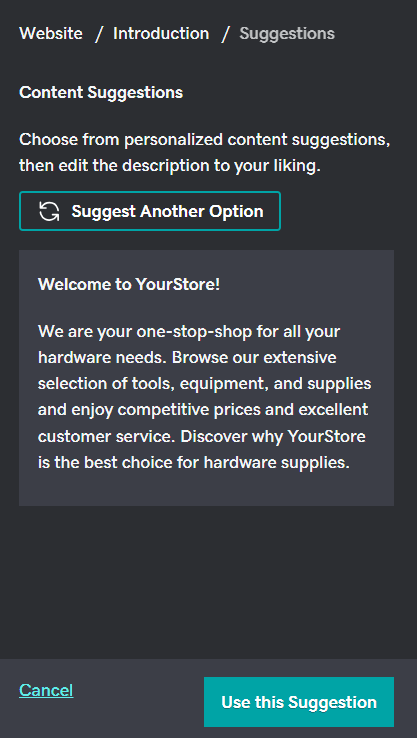
Adobe Portfolio, with a score of 0, does not have any AI capabilities. It is a website builder specifically designed for creative professionals to showcase their work, but it does not leverage AI technology to enhance its features or user experience.
User Management
User ManagementAssesses the platforms’ capabilities in managing user roles, permissions, and accessibility.Score Components:
- Role Customization (40%): Flexibility in creating and defining user roles and
permissions. - Ease of Management (30%): User interface and tools for managing users.
- Access Control (20%): Effectiveness of access control measures for different user
levels. - Scalability (10%): Ability to manage a growing number of users efficiently.
 7.3
7.3
 3.0
3.0
🏆 Winner: GoDaddy
. GoDaddy offers a more comprehensive user management system compared to Adobe Portfolio.
- GoDaddy allows multiple users to edit a website based on the hosting plan and website building tool. The free plan permits one user, while Deluxe and Ultimate plans allow up to five users with full editing permissions. In WordPress Hosting, there’s default support for unlimited users, each with customizable permission levels controlled through the WordPress dashboard.
- Adobe Portfolio, on the other hand, only allows one user to build and edit a website.
GoDaddy User Roles and Access Levels:
| Role | Description | Access Highlights |
|---|---|---|
| Account Holder | The primary owner of the GoDaddy Website Builder account. | Full access to all website builder features, domain management, hosting settings, and account settings. |
| Delegate Access | Users granted permission by the account holder to access specific parts of the GoDaddy account. | Can be given varying levels of access, from managing domains and products to making purchases on behalf of the account holder. |
| Website Editor | Users with permissions to edit and update the website through the Website Builder interface. | Can customize the website, add or edit sections (e.g., image galleries, menus), and update content. |
| Online Store Manager | Specifically for websites with e-commerce capabilities, managing product listings, orders, and payments. | Access to manage the online store, including product listings, coupons, shopping cart, shipping, and payments. |
Adobe Portfolio does not provide any information on user roles and access levels, indicating a lack of such features.
Additional Features

|

|
|
|---|---|---|
|
SSL Certificate |
|
|
|
Custom Domain |
|
|
|
Free Custom Domain Included |
|
|
|
International Domains |
|
|
|
Mobile Responsive |
|
|
|
Page Speed |
|
|
|
Website Builder Mobile App |
|
|
|
Convert a Website To An App |
|
|
|
Website Analytics |
|
|
|
Multilingual Sites |
|
|
|
Multiple Users |
|
|
GoDaddy vs Adobe Portfolio: User Feedback
Users generally praise GoDaddy for its affordability, reliability, and user-friendly interface, particularly in domain registration and hosting services. However, concerns include occasional interface changes, perceived slowness in website hosting, and dissatisfaction with pricing increases.
Adobe Portfolio, while not reviewed on G2, is designed specifically for creative professionals. Its integration with Adobe Creative Cloud and focus on visually appealing, responsive websites make it a popular choice among photographers, graphic designers, and artists. This specialization in showcasing creative work sets it apart in the GoDaddy vs Adobe Portfolio comparison.
The making of this blog
We followed a clear, step-by-step process to write and research this article.
GoDaddy vs Adobe Portfolio: FAQ
Which platform is better for creative professionals, GoDaddy or Adobe Portfolio?
Can I use GoDaddy for ecommerce websites?
How do GoDaddy and Adobe Portfolio compare in terms of ease of use?
Which platform offers better customer support, GoDaddy or Adobe Portfolio?
Are there any significant differences in hosting quality between GoDaddy and Adobe Portfolio?
Which platform is more suitable for users needing advanced marketing features?
How do the platforms compare in terms of security features?
Can I manage multiple users on either platform?











